Key takeaways:
- Feminist fashion serves as a medium for identity, activism, and empowerment, promoting inclusivity and dialogue about representation.
- Cultural awareness in fashion helps avoid misrepresentation and fosters empathy, emphasizing the importance of respecting the origins of styles and symbols.
- Collaborative experiences with designers from diverse backgrounds enhance understanding and appreciation of cultural narratives in fashion.
- Future goals for feminist fashion include promoting inclusivity, sustainable practices, and education for emerging designers to create respectful and representative narratives.
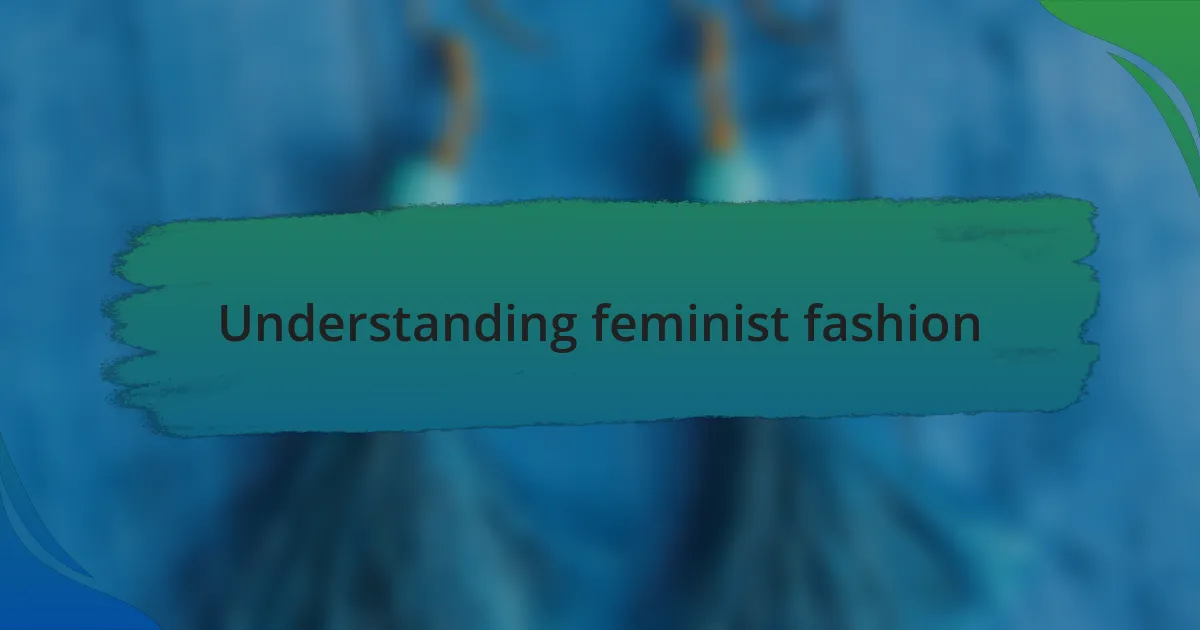
Understanding feminist fashion
Feminist fashion isn’t just about clothing; it’s a reflection of identity, activism, and empowerment. I remember attending a women’s march dressed in a handmade shirt that boldly declared, “My body, my choice.” It struck me how fashion can be a canvas for messages, amplifying voices and connecting individuals across diverse backgrounds.
At its core, understanding feminist fashion means recognizing its roots in the struggle for gender equality. It challenges societal norms, inviting us to question why certain styles are deemed acceptable or not. Have you ever wondered how your outfit might influence perceptions about your capabilities? I’ve felt the weight of that question, realizing that every garment I choose carries a message.
Moreover, feminist fashion creates a dialogue about inclusivity and representation. When I see diverse body types and cultures represented on runways or in marketing campaigns, it inspires me. It’s a reminder that every woman’s story deserves a spotlight, and fashion can play a pivotal role in celebrating our differences while uniting us in common causes.
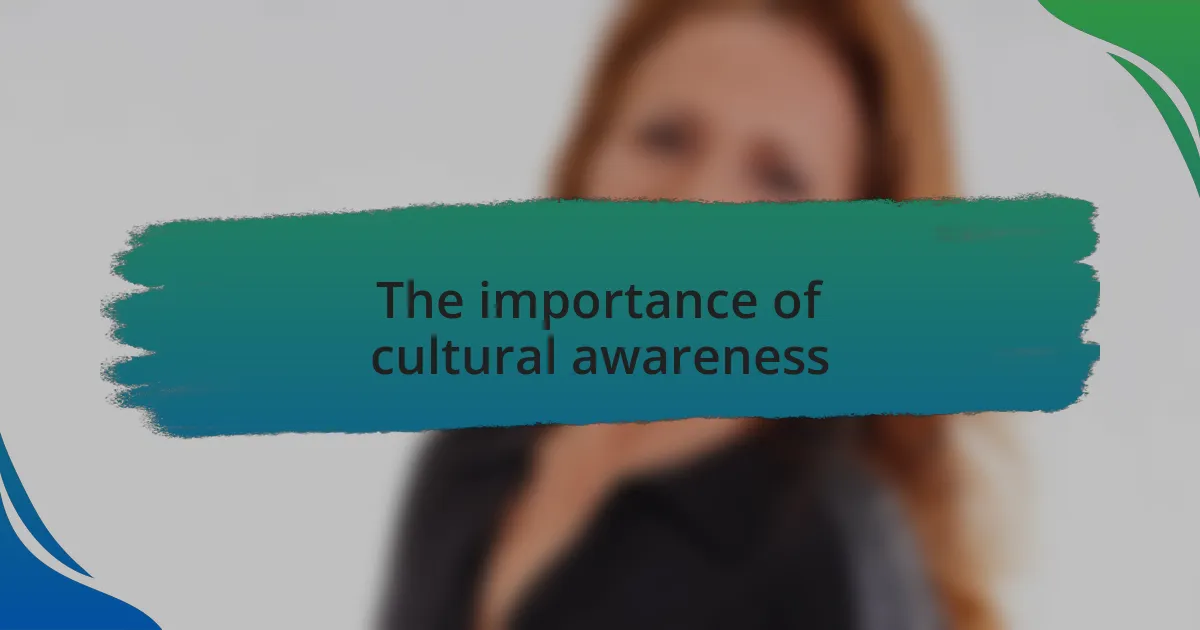
The importance of cultural awareness
Cultural awareness is crucial in feminist fashion because it allows us to appreciate the diverse narratives that shape women’s experiences worldwide. When I attended a cultural fashion show where traditional garments from various countries were showcased, I was struck by how each piece told a story. Has there ever been a moment for you when a piece of clothing made you feel connected to a culture outside your own? That connection can foster empathy and understanding, enriching our approach to fashion.
Understanding different cultures helps me avoid misrepresentations and stereotypes in fashion choices. I recall a time when I unknowingly wore a symbol that was sacred in another culture; the discomfort this caused reminded me of the need for respect in our sartorial expressions. Reflecting on these moments emphasizes the importance of knowledge in choosing designs that honor their original meanings rather than appropriating them.
Moreover, being culturally aware lends depth to our discussions about feminism in fashion. I often find myself engaging in conversations where the lack of sensitivity towards cultural symbols can lead to conflict or misunderstanding. What if we reframed our understanding of fashion to include a celebration of cultural identities rather than a dilution of them? Those discussions not only shape our personal aesthetics but help cultivate a more inclusive narrative within the broader feminist movement.
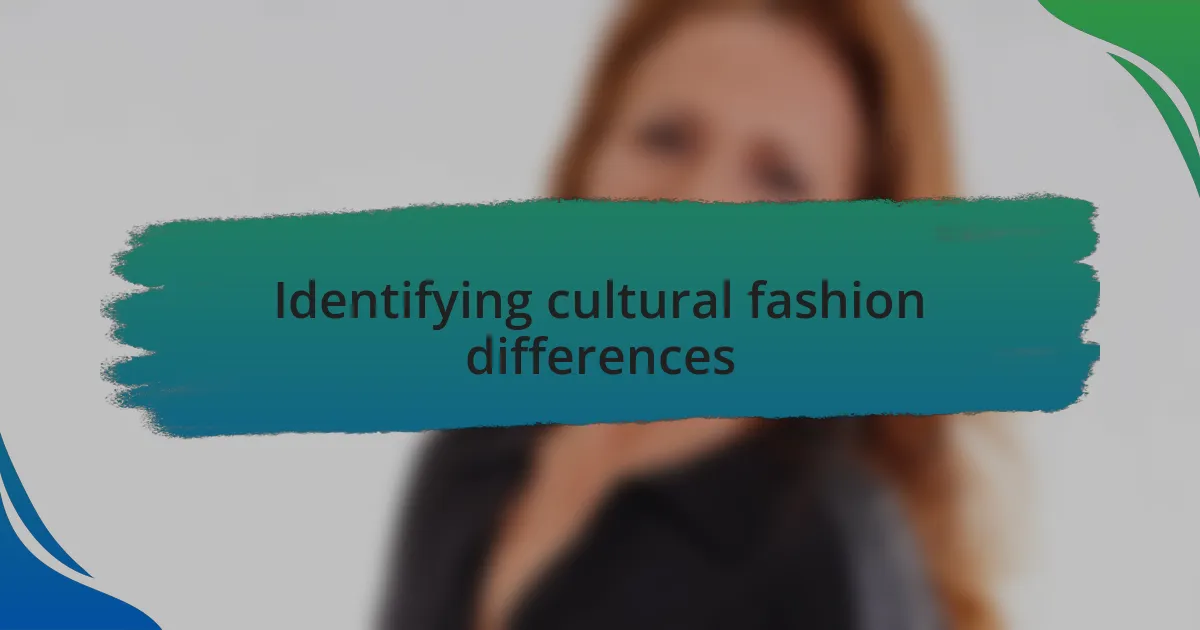
Identifying cultural fashion differences
Identifying cultural fashion differences requires a keen eye for detail and an open heart toward learning. I remember visiting a vibrant market in Morocco, where the intricate patterns of Moroccan caftans spoke volumes about the local heritage. Each stitch seemed to weave a tale of history, craftsmanship, and identity. Have you ever paused to consider what those patterns might represent in their cultural context? It made me realize how crucial it is to appreciate and respect the stories behind different fashion styles.
Different cultures often convey contrasting values through their fashion choices. For instance, during a collaborative project with artisans in India, I encountered textiles that emphasized modesty while still being incredibly striking. The ways in which clothing can highlight or conceal various aspects of the body resonate deeply with cultural norms and rituals. Reflecting on my own fashion choices, it challenged me to think about how I express my identity and what messages my clothing sends to the world.
Additionally, certain fabrics or colors hold unique meanings in their respective cultures. I learned this firsthand when I wore a traditional red dress at a family gathering, only to realize that in some cultures, red symbolizes celebration while in others, it represents mourning. This revelation was eye-opening and led me to question how often we impose our interpretations on others without fully understanding their values. How can we bridge these gaps in understanding through thoughtful fashion choices? It’s a journey worth taking, one that ultimately enriches our appreciation of global narratives.
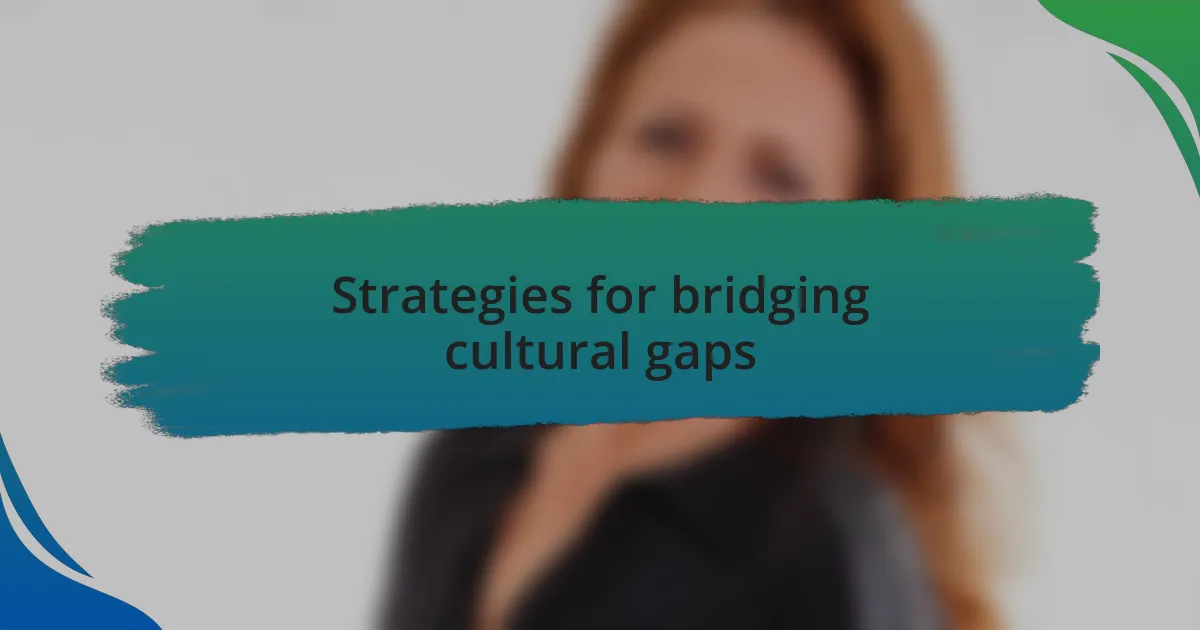
Strategies for bridging cultural gaps
One effective strategy for bridging cultural gaps is to engage in ongoing dialogue with individuals from diverse backgrounds. I recall a discussion with a designer from Nigeria who shared the significance of Adire fabrics, a traditional textile that tells stories of ancestry and heritage. This conversation not only broadened my understanding of the craft but also deepened my respect for the artisan’s role in preserving culture. Have you ever taken the time to ask someone about the traditional attire they cherish? Those conversations can unveil layers of meaning that transform simple garments into rich cultural narratives.
Another approach is to incorporate cultural elements thoughtfully into one’s fashion choices while maintaining respect for their origins. I once wore an Indian kurta to a community event, ensuring it was styled with sensitivity towards its cultural roots. This decision sparked conversations about cultural appropriation and appreciation, shedding light on how fashion can serve as a bridge for understanding rather than division. Isn’t it fascinating how a piece of clothing can initiate such impactful discussions?
Lastly, actively seeking collaborative opportunities with artisans can create spaces where cultures intersect. During a workshop, I teamed up with indigenous artists to blend traditional prints with modern silhouettes, allowing their voices to shine through. This experience reinforced the idea that collaboration isn’t just about merging styles; it’s about creating a platform for cultural expression that honors both sides. Have you thought about how your fashion practices could empower others while advocating for cultural visibility? It’s a powerful way to foster understanding and unity.
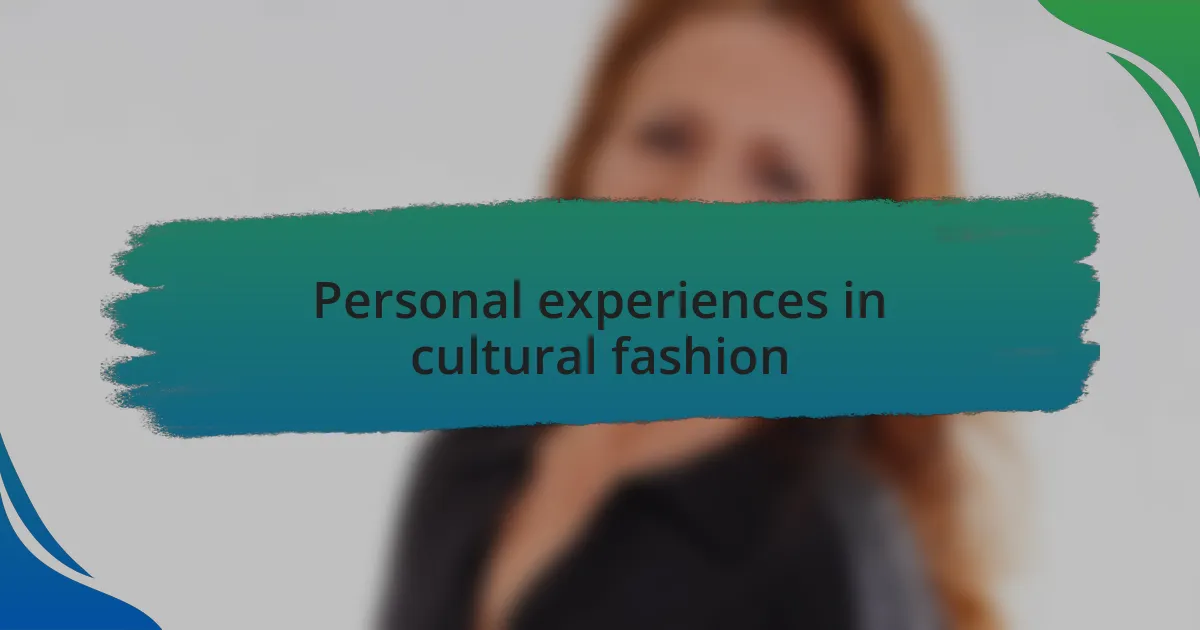
Personal experiences in cultural fashion
Navigating the world of cultural fashion has been a journey filled with eye-opening experiences for me. I remember attending a local festival where I was captivated by the vibrant patterns of Mexican textiles displayed by local artisans. My decision to wear a handmade dress that featured those very fabrics caused me to reflect on the stories woven into each thread. Have you ever felt that magic of wearing something that connects you to a culture? It made me realize how clothing can carry the weight of history and the joy of celebration.
While traveling in Morocco, I was intrigued by their use of colors and intricate designs in kaftans. One afternoon, I had the privilege of a tailor explaining the significance behind the motifs and how they represent not just beauty, but also identity. It was an emotional moment for me to understand that what I viewed as simply beautiful fabric carried deep personal meaning. Has a conversation ever transformed your perception of fashion? It affirmed for me the importance of listening and learning as part of my style journey.
Working with designers from various backgrounds has profoundly shaped my views on cultural fashion. I participated in a project where we combined traditional Balinese patterns with contemporary trends to create a collection. Witnessing the excitement of the local artists as their heritage was celebrated in a new light was incredibly fulfilling. It made me ponder: how often do we forget to give voice to those who create the art we admire? This collaborative spirit not only bridges gaps; it fosters a community where fashion becomes a shared language of respect and inclusion.

Lessons learned from cultural exchanges
Cultural exchanges have taught me that understanding fashion goes far beyond aesthetics. During a workshop with designers from India, I saw firsthand how the vibrant colors of sarees are infused with symbolism, often representing life events and community ties. It left me wondering: how often do we take the time to uncover the narratives behind what we wear?
A memorable exchange occurred when I participated in a collaborative design session focused on African tribal prints. One of the designers shared her family’s history and how each pattern told a story of resilience and heritage. I couldn’t help but feel a deep connection to these stories, realizing that fashion is not just a personal choice; it’s a collective journey. Have you ever discovered a piece that spoke to your identity in ways you hadn’t expected?
From these interactions, I’ve learned that fashion can be a powerful bridge, fostering empathy and appreciation across cultures. I once joined an online forum where individuals from various backgrounds discussed their traditional garments, and it was enlightening to hear how these pieces represented their values and beliefs. It made me appreciate how fashion can unite us, encouraging dialogue that highlights our shared human experiences.
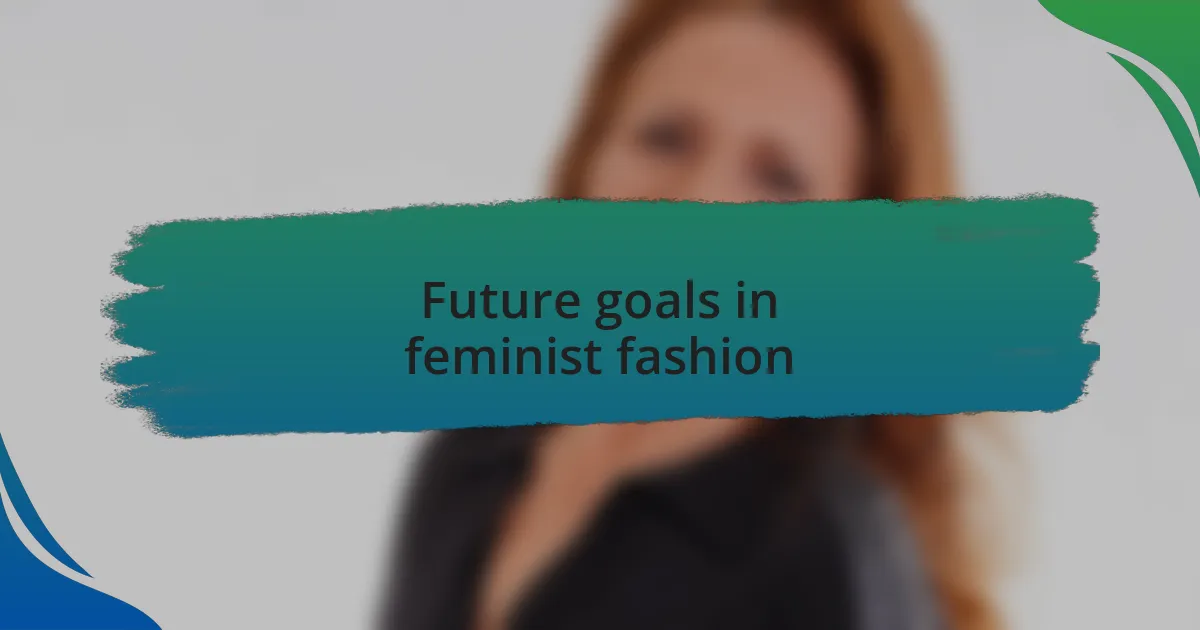
Future goals in feminist fashion
The future of feminist fashion is genuinely exciting as it aims to create a more inclusive industry. I envision a world where diverse voices shape trends and styles, ensuring that marginalized communities receive recognition and representation. Imagine walking into a store and seeing attire that not only celebrates a variety of body types but also tells stories from different cultures. Wouldn’t it be empowering to wear something that resonates with your identity while respecting another culture’s heritage?
As I reflect on past experiences, I recognize the power of sustainable practices in this movement. One day, I participated in a local initiative that advocated for eco-friendly materials, where we discussed how fast fashion disproportionately impacts women in textile-producing countries. The conversations ignited a passion within me to champion brands that prioritize ethical sourcing and fair labor practices. It truly feels like our choices can ripple outward, projecting the values of respect and equity in every stitch.
Moreover, I believe a pivotal goal for feminist fashion is education. When I attended a panel discussion on gender inclusivity in fashion design, it became clear that many designers are eager to learn but lack the right resources. I left pondering: how can we create spaces that foster knowledge-sharing and mentorship among emerging designers? Imagine a future where seasoned professionals share their experiences, empowering the next generation to create not just beautiful garments but narratives that resonate across cultures.